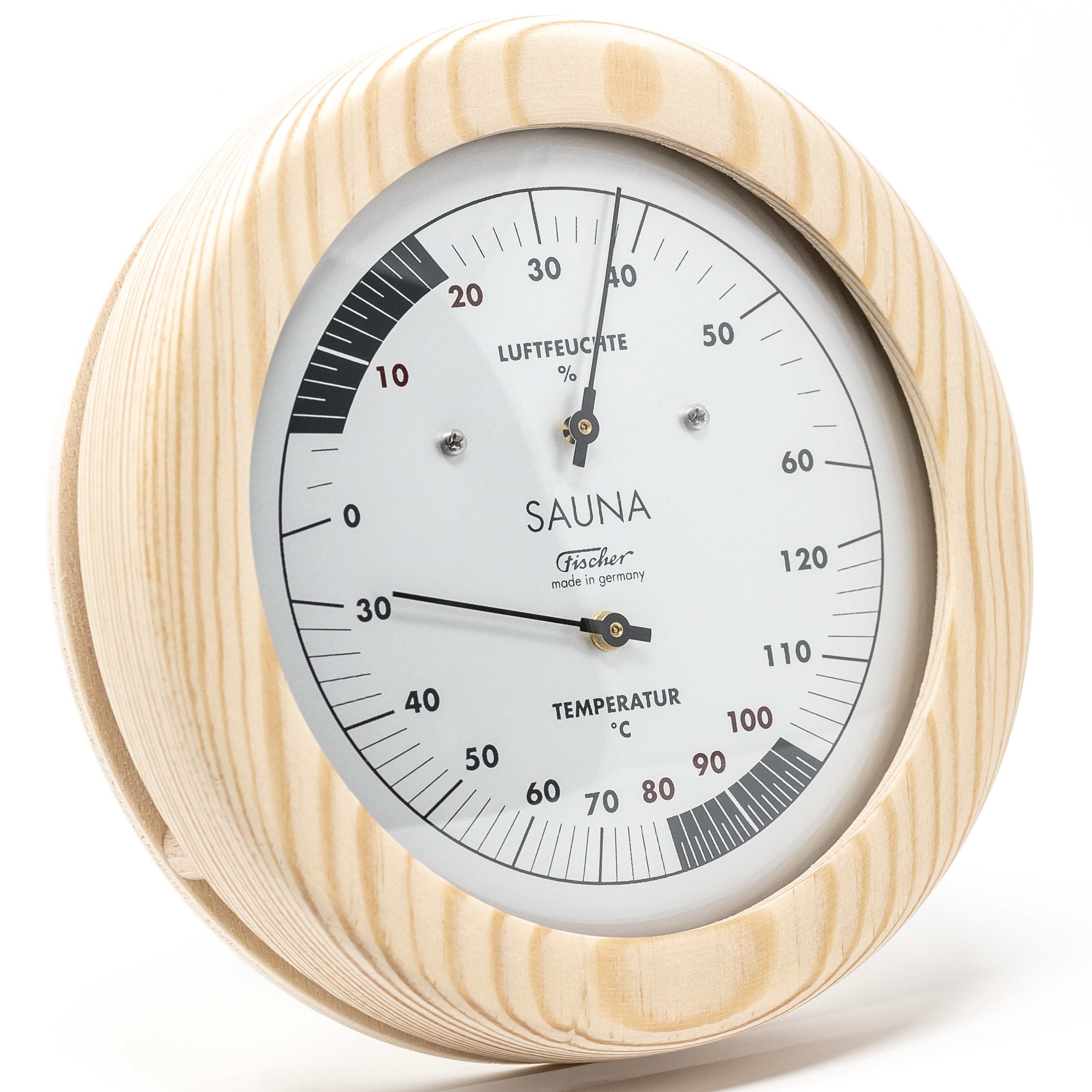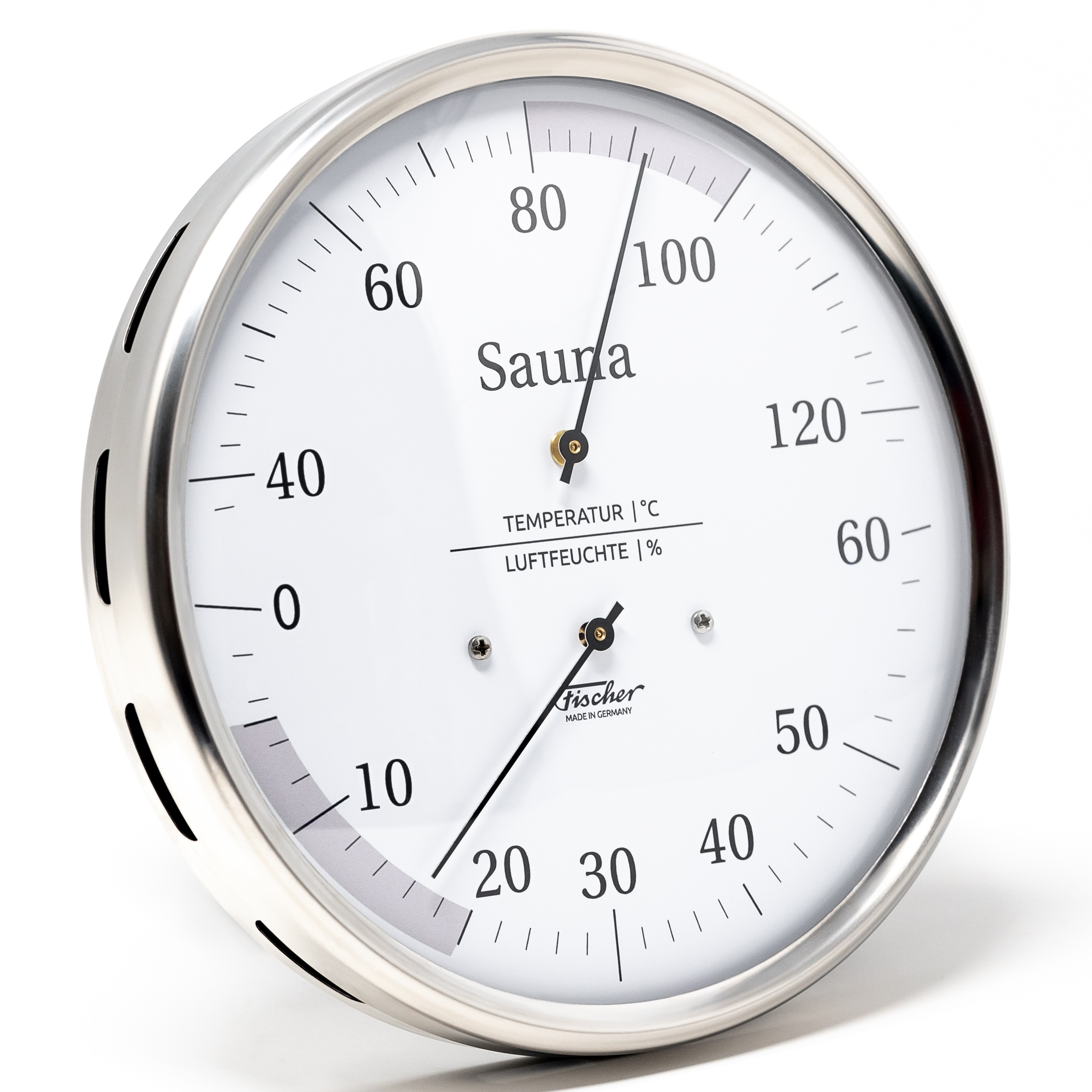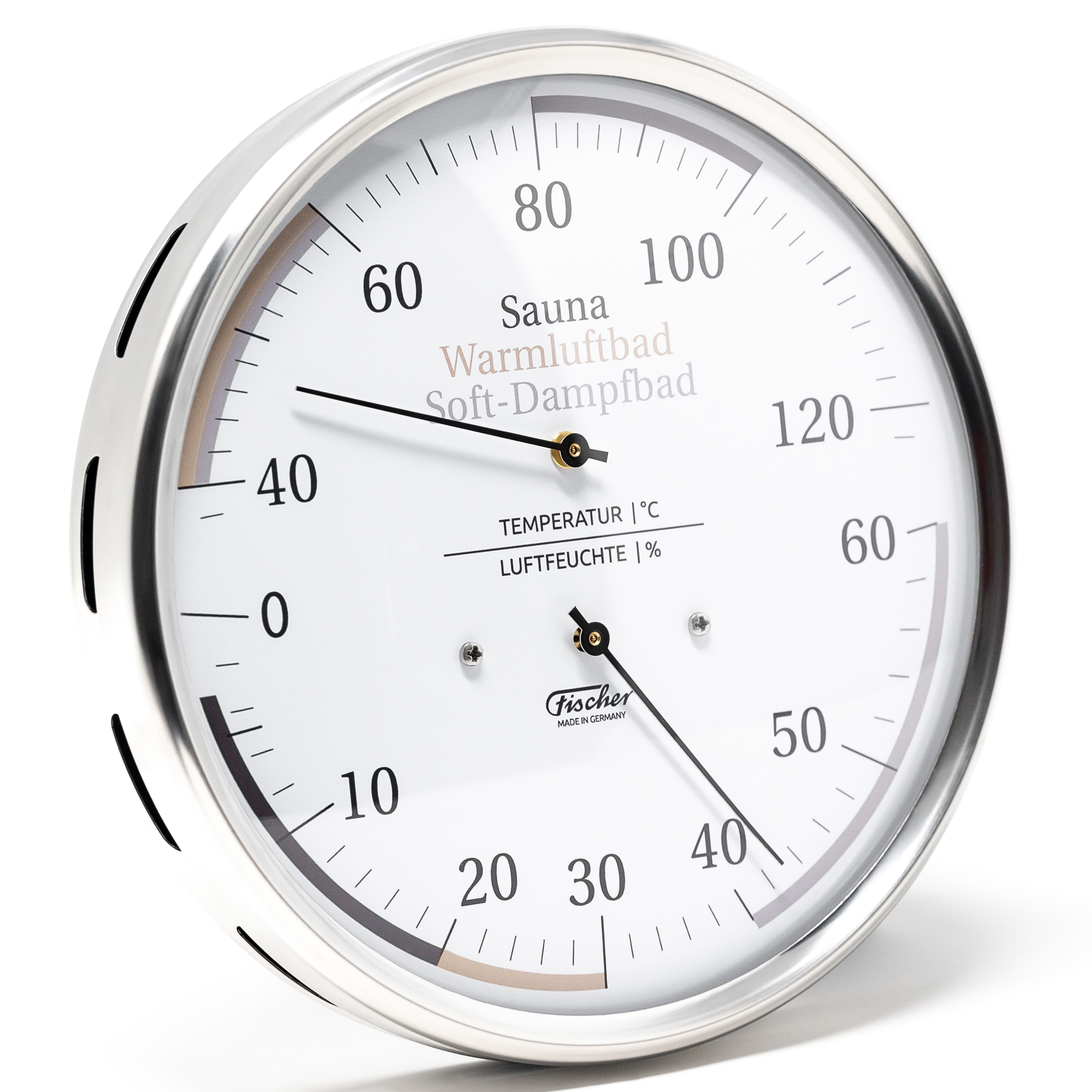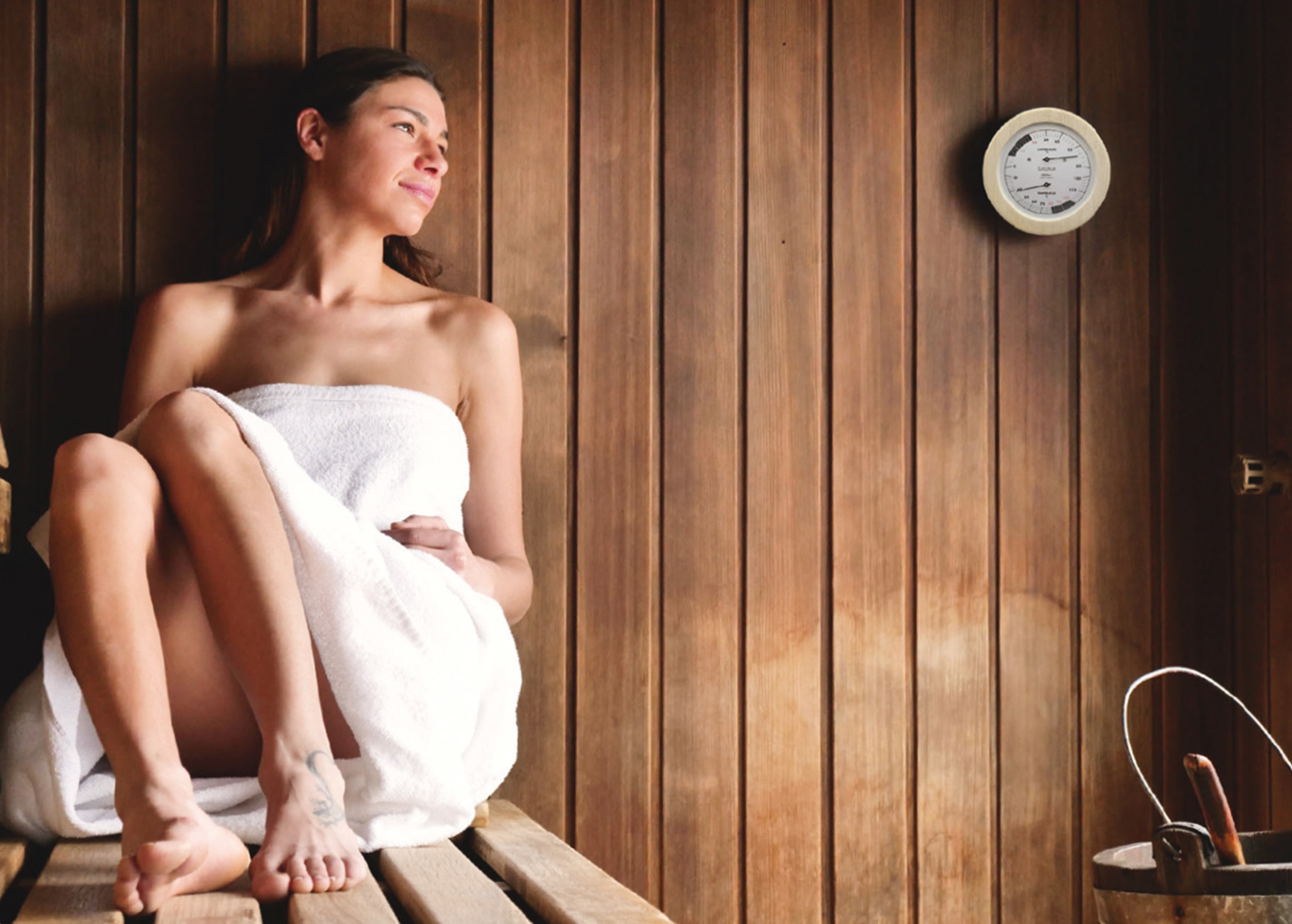Sweat bath is a tradition that has been cultivated by people for thousands of years. On one hand, sauna serves for relaxation and on the other hand, it also promotes health: the skin is cleansed, muscles regenerate and you strengthen your immune system. However, all this assumes that the air temperature and humidity are properly adjusted. Otherwise, cardiovascular problems could occur. The proven thermometers, hygrometers and thermohygrometers from FISCHER make it easy for sauna lovers to recover in a healthy way. Thanks to their measuring accuracy, the instruments are used in saunas all over the world.

The importance of humidity and air temperature in the sauna.
Saunas have their own, very special climate, which is characterized by high temperatures on the ceiling and much lower temperatures on the floor. While Finnish saunas in particular have a ceiling temperature of 100 °C, the temperature at the level of the top bench is about 70 °C, and near the floor it is only 40 °C. The strong temperature gradient is due to the fact that the air entering the cabin from outside heats up strongly in the sauna heater, expands and thus becomes lighter and rises to the ceiling. Subsequently, the high air temperature cools down on the sweating skin of the sauna bathers, becomes heavier and sinks again. It is then discharged to the outside again via the sauna cabin's venting system.
In addition to its specific structure, a sauna is thus characterized not only by the high air temperature inside, but also significantly by the prevailing relative humidity. The ratio of temperature and humidity is decisively responsible for how the heat in the sauna is perceived. Relative humidity is the amount of water vapor contained in the air. An increase in air temperature is accompanied by a decrease in relative humidity, so humidity is determined by the prevailing temperatures in the sauna. The normal values of relative humidity are as follows:
· 60 °C: 15 bis 30 % rel. humidity
· 80 °C: 8 bis 15 % rel. humidity
· 100 °C: 3 bis 8 % rel.humidity
It is hot and dry in the Finnish sauna, where the usual air temperature is 80-100 °C and the relative humidity is only 5-10 %. This only increases briefly during an infusion, when water is poured onto the hot stones of the sauna heater and rises almost immediately as hot steam. Due to the high temperatures, sauna bathers usually spend up to 15 minutes here.

Bio saunas have an average air temperature between 45 and 60 °C with a relative humidity of 40-55 %. They are the lighter version of a Finnish sauna and sauna bathers can spend up to 30 minutes here. In a steam sauna or steam bath, it is comparatively "cool" at a maximum of 50 °C, with the characteristic relative humidity of 100 %.
Depending on their preferences and state of health, sauna bathers prefer different saunas because of the humidity and air temperature present. Some people breathe and relax in a dry Finnish sauna without any problems, while in the steam sauna they can relax less successfully in some cases due to the high humidity and displaced oxygen. For others, it's the other way around: they find the extremely low humidity and heat in a Finnish sauna unpleasant, but the higher relative humidity in bio saunas ideal.
How to measure relative humidity and air temperature in saunas?
Now, how to check whether the recommended air temperature and humidity in your sauna? With a thermometer and a hygrometer. The thermometer is used in saunas to measure the current air temperature in °C. The measuring element is a bimetal. The measuring element used for this purpose is a bimetal with high specific deflection, which reacts to temperature changes with only low inertia. This is also important because the temperature in a sauna rises or falls very quickly as a result of an infusion or brief ventilation.
To measure relative humidity, the hygrometer is used, which displays the values as a percentage. The measuring element is industrially manufactured synthetic hair, which expands as the humidity rises. The humidity-dependentchange in length is transferred to the pointer by a fine mechanism. Due to the special treatment of the hair, the hygrometer reacts almost inertia-free to any change in humidity. In addition, the measuring mechanism of the hygrometer is temperature-compensated.
Where should the instruments for measuring humidity and air temperature be placed in the sauna?
In a sauna there are relatively large differences in temperature and, accordingly, differences in relative humidity. Therefore, hygrometers and thermometers must be placed in the right place in the sauna to produce correct values. Place the gauges at the head height of the person sitting on the top bench. In most cases, this is 20 to 30 cm below the ceiling. The sensor of the sauna control unit is usually located at the hottest point in the sauna, i.e. close to the sauna heater. Therefore, do not place your measuring device directly above the sauna heater. There are always differences between the set and the measured air temperature.
What should be considered when using an outdoor sauna?
In the winter months, temperatures in an unheated outdoor sauna quickly drop to values around 0 °C or even below. Since such temperatures are well outside the measuring range, the thermometer pointer will go off the temperature scale. In the case of a combined thermometer-hygrometer, the thermometer pointer will run into the humidity scale and will be blocked at the hygrometer pointer axis at the latest. The same applies to the pointer of the hygrometer, which may stop at such temperatures beyond 60 % relative humidity (i.e. in the temperature scale of combined sauna instruments). However, this does not damage the measuring instrument. In the heated sauna, both pointers return to their respective scales.
Measure humidity and air temperature for the successful sauna session.
An ideal place to relax and unwind is the sauna. It is not without reason that it is nowadays an integral part of wellness offers. In addition to the time out you can enjoy in the sauna, the health aspect should not be neglected: saunas can prevent colds, stimulate blood circulation, relieve tension and cleanse the skin. In addition to the Finnish sauna as one of the most popular types, however, steam and bio saunas are also enjoying ever greater growth. These differ significantly in the prevailing air temperature and humidity. Since many private individuals now also install a sauna in their own homes, it is important to know exactly how the prevailing air temperature and humidity can be measured so that nothing stands in the way of a successful sauna session.

Thermometers, hygrometers and thermohygrometers from FISCHER for accurate readings.
Choose the high-quality thermometers, hygrometers and thermohygrometers from FISCHER, which provide you with accurate readings at all times! They are accurately tested at the factory in a climatic chamber under sauna conditions, i.e. at 80 to 100 °C and 0 to 20 % relative humidity. Possible corrections to the display therefore only have to be made in exceptional cases. These can be carried out with a suitable screwdriver. In FISCHER sauna hygrometers, the correction screw is made of brass and is visible at the side opening of the housing. The opening in sauna thermometers from FISCHER is instead located on the back of the housing, in the back of the pointer axis. For correction, the screwdriver should be inserted into the visible slot of the movement.
If you have any questions about our measuring instruments or other concerns, we are always available to advise you. In this case, please contact us!






